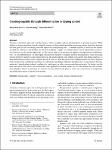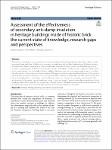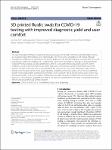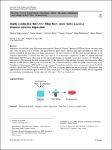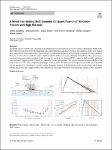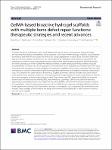Search
Author
- Osman, Ahmed I. (5)
- Daqing, Ma (3)
- Jorgensen, Ed (3)
- Li, Yan (3)
- next >
Subject
- kinh tế (26)
- Economics (12)
- programming (10)
- XRD (10)
- next >
Date issued
- 2020 - 2025 (2129)
- 2010 - 2019 (129)
- 2000 - 2009 (9)
- 1999 - 1999 (1)
Has File(s)
Search Results
Awareness of human rights and related principles, such as equality and non-discrimination, is growing in sports. While debates on doping regulation typically target the contours of the prohibition and the sanctioning regime, much less attention has been given to how anti-doping detection impacts the level playing field, i.e. whether equality is realised in the manner in which the substances and methods are detected in athletes’ samples, or whether athletes are all equal when it comes to the analytical cut-offs that the regulations set. This article seeks to fill this gap and explores the implications of differentiation—or non-differentiation—in anti-doping detection for principles of equality and non-discrimination. After discussing notions related to equality in anti-doping detecti... |
We use an in-depth survey of institutional investors investing in Japan to reveal the homogeneity and heterogeneity of their views on corporate governance regulations. Their opinions exhibited high homogeneity in favoring legislative intervention in corporate management but nuanced heterogeneity with respect to the degree of intervention that they regarded as desirable. A certain cluster of investors, to which investment trusts and advisors were more likely to belong, tended to prefer stronger legal intervention; these investors favored strict tender-offer rules, and they more clearly supported intervention in the composition of boards and the pursuit of executive liability. These reactions may have been motivated by concern for the fact that a certain class of shareholders, particu... |
The article investigates the significance of syntax in the multilingual EU law. It attempts to respond to the question whether syntax is apt to contribute to the uniformity of that law and how, with regard to this function, it relates to the (widely disputed yet uncontested) semantic and pragmatic methods of achieving such a uniformity. In order to respond to this question, the article firstly, recalls fundamental concepts which would help conceptualize the endeavour and, secondly, presents examples of analysis of syntax arrangements which can be deemed representative for the study of the said problem of contribution. The study finds that EU law (expressed in 24 official languages which have equal authentic status) relies on diversified syntax of its respective constitutive language... |
Destruction caused by excessive moisture is a common problem in heritage buildings made of brick. Historic buildings usually have walls that of different constructions, i.e. walls with all joints filled, walls without filled vertical joints, and walls with a layered arrangement. Excessive moisture causes brick cavities, reduces the load-bearing capacity of walls, is unsightly, and can lead to the destruction of walls or the failure of a building. Secondary anti-damp insulation is used to protect the brick walls of historic buildings. However, there has not been enough research to confirm the effectiveness of secondary anti-damp insulation. This type of insulation is performed with the use of the injection method, with various factors (such as soils, the type of injection material, e... |
The current standard method of diagnosing coronavirus disease 2019 (COVID-19) involves uncomfortable and invasive nasopharyngeal (NP) sampling using cotton swabs (CS), which can be unsuitable for self-testing. Although mid-turbinate sampling is an alternative, it has a lower diagnostic yield than NP sampling. Nasal wash (NW) has a similar diagnostic yield to NP sampling, but is cumbersome to perform. In this study, we introduce a 3D printed fluidic swab (3DPFS) that enables easy NW sampling for COVID-19 testing with improved diagnostic yield. The 3DPFS comprises a swab head, microchannel, and socket that can be connected to a syringe containing 250 µL of NW solution. |
One of the influential contributions to criminalisation theories is Duff’s work on public wrongs, which offers a thin master principle of criminalisation, proposing that we have a reason to criminalise a type of conduct if it constitutes a public wrong; one that violates a polity’s civil order and forms part of that polity’s proper business. The nature of the civil order, the scope of its proper business, and the distinction between the public and private realms of wrongs are context-relative to each polity, structured by their legal, institutional, and informal values and ways of life. Such a context-relative view led to problematic criminalisation examples raised by Duff and his critics. This article engages more fully with the relativism of the civil order and public wrongs in no... |
Ruthenium dioxide (RuO2) thin films were synthesized by Chemical Solution Deposition (CSD) on silicon substrates using only water and acetic acid as solvents. The microstructure, phase purity, electrical and optical properties as well as the thermal stability of the thin films have been characterized. The microstructure of the thin films strongly depends on the annealing temperature: A smooth thin film was achieved at an annealing temperature of 600 °C. Higher annealing temperatures (800 °C) led to radial grain growth and an inhomogeneous thin film. A very low resistivity of 0.89 µΩm was measured for a 220 nm-thick thin film prepared at 600 °C. The resistivity of the thin films increases with temperature, which indicates metallic behavior. |
The nature of snow and the ever-changing environment makes measuring friction on snow and ice challenging. Additionally, due to the low friction involved, the equipment used must exhibit high sensitivity. Previous investigations of ski–snow friction have ranged from small-scale model experiments performed in the laboratory to experiments with full-sized skis outdoors. However, few have been conducted under conditions similar to those encountered during actual skiing. Here, we present a novel sled tribometer which provides highly reproducible coefficient of friction (COF) values for full-sized skis gliding at relevant speeds (approximately 5.9 m/s) in a controlled indoor environment. The relative standard deviation (RSD) of the COF is as low as 0.5%. The continuous recording of veloc... |
Digital games can be considered as composed of two main components: the props, i.e. visual, textual, and aural elements such as codes, 3D models and animations; and the form, specially the interaction between players and games, the act of playing itself. This dichotomy thus begs the question whether digital games are indeed games if nobody plays them, and ultimately: who is the owner of the gameplay and any by-product of the interaction between the game and the players? This paper explores the copyright status of content created by users with digital games, such as gameplay videos and images, for example art based on digital game assets, namely virtual photography; as well as customized in-game objects. Many modern digital games offer considerable freedom to players, in terms of how... |
Currently, the clinical treatment of critical bone defects attributed to various causes remains a great challenge, and repairing these defects with synthetic bone substitutes is the most common strategy. In general, tissue engineering materials that mimic the structural, mechanical and biological properties of natural bone have been extensively applied to fill bone defects and promote in situ bone regeneration. Hydrogels with extracellular matrix (ECM)-like properties are common tissue engineering materials, among which methacrylate-based gelatin (GelMA) hydrogels are widely used because of their tunable mechanical properties, excellent photocrosslinking capability and good biocompatibility. Owing to their lack of osteogenic activity, however, GelMA hydrogels are combined with other... |

